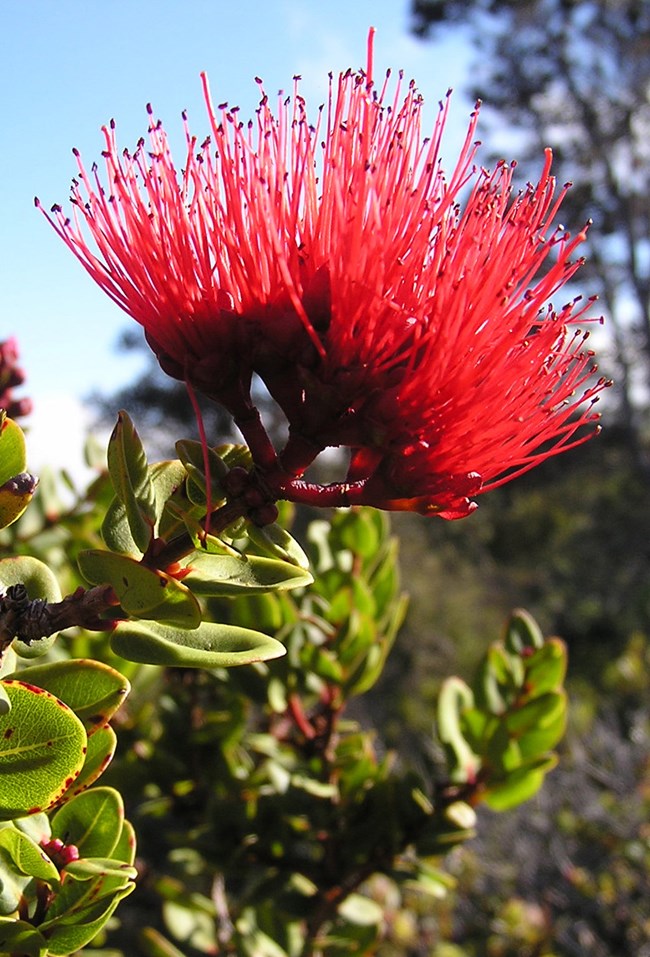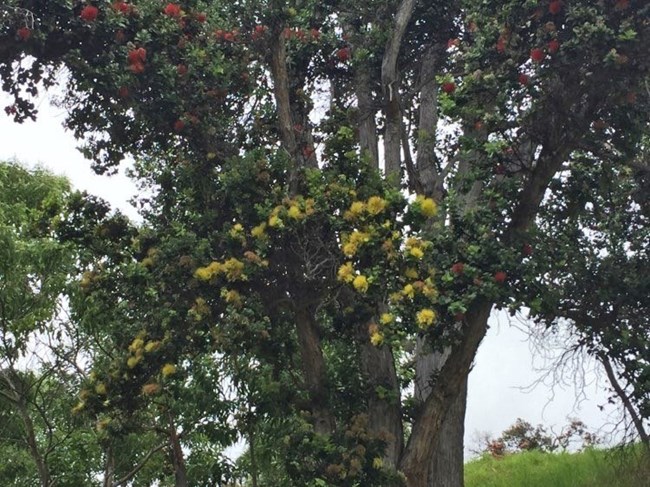Last updated: November 2, 2021
Article
ʻŌhiʻa

He went straight to the spring, plunged in headlong, and was changed into an ʻōhiʻa tree.
- Pukui and Green (1995)
The endemic ʻōhiʻa lehua tree (Metrosideros polymorpha) epitomizes Hawaiʻi and is an integral part of Native Hawaiian culture. It is almost impossible to avoid the mention of the native ʻōhiʻa tree and its lehua blossoms when listening to Hawaiian moʻolelo (stories) and ʻoli (chants). Today there are two common, contrasting, stories about how the ʻōhiʻa lehua was created.
A well-known, and most likely modern, story tells us of how the volcanic deity Pele and her jealousy transformed two lovers into the ʻōhiʻa lehua.
Pele had a strong romantic interest in an attractive man named ʻŌhiʻa. ʻŌhiʻa was already in love with a woman named Lehua, however. In an act of wild jealousy, Pele transformed him into a gnarled tree. Pele refused to undo what she had done, and so Lehua asked her ʻaumakua (deified family ancestors) to intervene. They decided to transform her into the brightly-colored blossom that adorns the ʻōhiʻa tree so they could forever be together. To this day, it is said that if you pick the tree’s flower it will begin to rain because the two lovers are being separated.

A different traditional story tells us about the stinginess of a wife that led to a series of unfortunate events and the transformation of a man into an ʻōhiʻa tree.
Kūkaʻōhiʻalaka and his sister, Kauakuahine, voyaged to the island of Hawaiʻi from the distant land of Kahiki. Kūkaʻōhiʻalaka was known to be an excellent fisherman. He instructed his wife to share their caught fish with his sister when she brought them fresh vegetables from where she lived. However, unbeknownst to him, his wife was stingy and jealous. When Kauakuahine came from the mountains to bring vegetables for her brother’s family, his wife would only give her salt because she hated to give away the dried fish. Everyday Kauakuahine would return to her sister-in-law, but it seemed useless to burden herself with carrying vegetables to only return with salt and seaweed for her patient family. One day, her husband and her children ran out to meet her when she came near the house. In frustration, she gave each of them a slap! This changed them into rats, and in despair, she turned herself into a spring.
After the transformation, the spirit of Kauakuahine traveled across the ocean to tell her brother Kūkaʻōhiʻalaka of her fate. Kūkaʻōhiʻalaka returned home and confronted his wife after having this vision. He saw the dried fish laid beneath the sleeping mat of their house and confirmed his suspicion that his wife was responsible for the misfortune of his sister. He became angry at his wife for being a cruel person, and then proceeded to beat his wife to death. Kūkaʻōhiʻalaka hastily ascended to the old home of his sister’s family in ʻŌlaʻa forest. In tears, he dropped to the edge of the spring. Rats scampered where the house stood and there was a fine rain. He dove head first into the spring and changed into an ōhiʻa tree. Oral tradition tells us that to this day the tree is the embodiment of Kūkaʻōhiʻalaka - worshiped by those who go up into the forest to hew out canoes. This tree bears two different blossoms, and blood will flow from the tree if a branch is broken.
Modern or traditional, the kaona (hidden meaning) of these two very different stories share something valuable with us.
Having been shared by many Hawaiians over long periods of time, different versions of moʻolelo may vary, in some cases significantly.
